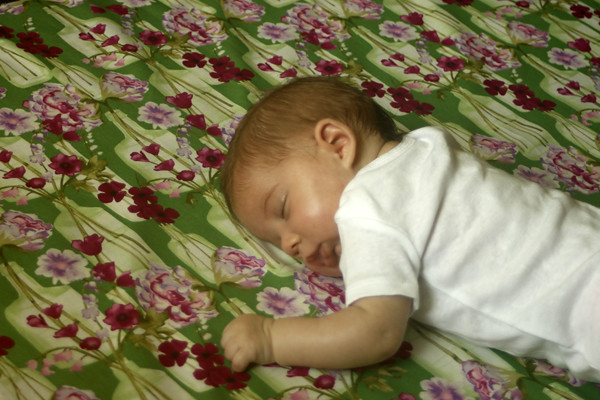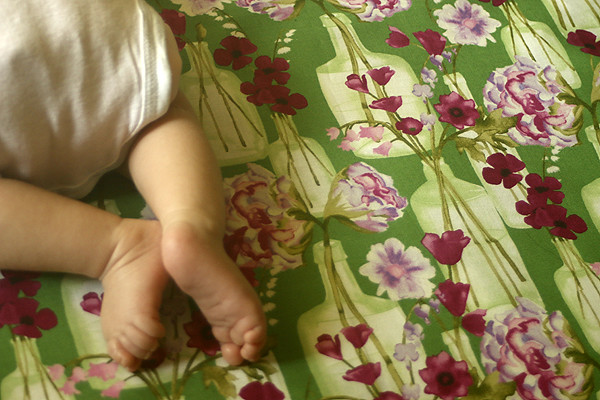Eleni, 3 months


It seems miss Eleni was rather uninspired by the prospect of a photo shoot this morning. She fell right asleep, so I rolled her over and decided we could work with that. Today's photographs are captured on a Vignette fabric by Laura Gunn for Michael Miller. I love that saturated green!
For those just joining us, our baby suffered from oxygen deprivation prior to birth, with an MRI showing severe global brain damage. She is disabled as she is unable to take food by mouth and has early signs of cerebral palsy. Because of her birth trauma, her brain sends too many activating messages to her muscles, resulting in excess muscle flexing and tightness that discourage normal movements. Her brain damage also manifests in difficulty breathing and using her eyes. So many things rely on muscle control!
Sleep is not an unusual state for our sweet baby. She's hardly ever awake and can even sleep through her feedings, since she's tube fed. I'd love to see her more alert and interactive! But at least Eleni is gaining well, weighing about 10.5 lbs at 3 months, up from her birth weight of 5 lbs, 11 oz. We are pleased that her head growth is normal, which means her brain is at least growing. Growth is good. Here she is slumbering away during her bath this morning!
A photo posted by Rachel Hauser (@stitchedincolor) on May 29, 2015 at 7:54am PDT
Ok, so today I want to tell you about something new we are pursuing for our baby, but first a little background about cerebral palsy (CP). If you do even a little research about cerebral palsy, you will read again and again that it is not treatable. It is also not "progressive" in the sense that the damage to the brain happens at one time and does not continue to get worse and worse. However, the effects of the damage do get worse and worse, often causing deformities that physical therapy (especially stretching) may prevent. There are 5 levels of CP, ranging from so slightly effected that it's mostly undetectable to severely effected with all four limbs unusable and difficulties with basically every bodily function. It can be really, really bad. The crazy-causing part is that no one can tell you how your child will be effected. It's all wait and see. Some babies with severe brain damage wind up doing very well and vice versa.
I'd like to take issue with the "not treatable" aspect of this tale.
In the last 15 or so years, neuroplasticity (the ability of the brain to change it's own structure and functioning, i.e. to reorganize or "heal" itself) has become a proven scientific phenomenon. However, it seems that when dealing with CP the medical establishment has missed the memo. Perhaps, because neuroplasticity is so new, treatments to induce brain reorganization and healing have not yet been proven. As a result, healing therapies are never mentioned by neurologists (gah!) and certainly not covered by insurance.
Obviously, that won't stop parents. A bit of searching the net yields a bunch of alternative therapies for CP. While Eleni was still in NICU, a research-oriented friend gave me a copy of a book describing what is probably the most popular and/or promising treatment: Anat Baniel Method (ABM). So, the short version is
We're doing it! And, it may be working.
ABM is a physical, movement therapy that aims to treat the brain. The brain learns to move in infancy through a wide variety of random movements. For a CP child with tight muscles, these movements don't happen and hence the child will struggle to learn to roll over, crawl, sit, etc. Practitioners of the Anat Baniel Method touch and move the child in ways designed to provide the information the child's brain needs to learn how to move. Results can be quite dramatic or more slow and minor. But this is key - from what I can tell, most children do make progress learning how to MOVE parts of their body they could not previously move.

Obviously I am afraid to be too optimistic, but I'm also darn sure going to try. Eleni received her first session (6 clustered lessons) about a week ago. Since her lesson she's done many new things, some just once or twice and some over and over again. The most important change is that she is now able to hold her head in midline at times. By that I mean she does not always turn her head completely to one side (maybe passing through midline, but never staying there). She has found her "center" which is foundational to so much future learning and growth. She does not always choose midline, but it is approaching 50% of the time. That's HUGE!
Some other little improvements we noticed during and after the session are: rolling from back to each side, sucking with cheek involvement, large left leg kicking, vocalizing a new sound and bringing her hands together low over her belly when lying on her back.
Honestly, I was very guarded, during and after the ABM sessions, against allowing myself to believe that change had occurred. My mother, who traveled with me for this out-of-town therapy, was trying to tell me that Eleni was definitely turning her head and eyes to voices, especially mine. I'll never forget what happened when we arrived home from our travels. My mom and I were on opposite sides of Eleni, who was strapped in her carseat. I spoke to Eleni and she turned her head from midline to look at me, with her eyes. I stopped talking and my mother began calling to her. Eleni turned all the way to my mom. When mom stopped and I spoke to Eleni again, she turned right back to me. Such a little thing, but so much! So very, very much!
Since our session last week, Eleni has been using her eyes better, focusing on people and sometimes on toys several times each day. Still, when she doesn't do her "new" things I so easily feel despair. Did I imagine that? Is this authentic progress? Did she already forget how? I know that change doesn't have to be constant to be real, but it's so hard to feel that truth when your child turns away, unresponsive again and again.
Of course, the only way to know if it was ABM that brought these changes would be to go back in time and not do the ABM treatments. Just as with anything we do to help her, it's impossible to know with certainty what exactly is working. But my instinct is that the changes we've seen are so clustered and so developmentally significant (here I mean the head at midline) that we must continue on. We will do two more sessions (6 lessons each) in June and then evaluate this alternative treatment.
I hope beyond hope that by that time there is no question in our minds that our child's brain is reorganizing itself in a helpful, healing way!
Thanks again for taking this journey with me.
xo,
Rachel

